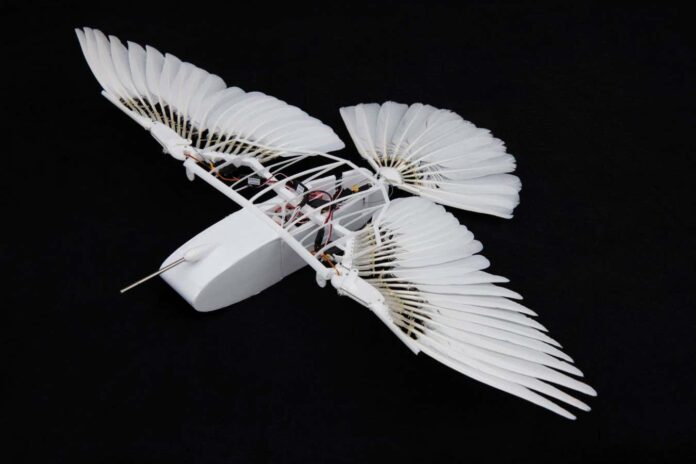A pigeon-inspired robot has solved the mystery of how birds fly without the vertical tail fins that human-designed aircraft rely on. Its makers say the prototype could eventually lead to passenger aircraft with less drag, reducing fuel consumption.
Tail fins, also known as vertical stabilisers, allow aircraft to turn from side to side and help avoid changing direction unintentionally. Some military planes, such as the Northrop B-2 Spirit, are designed without a tail fin because it makes them less visible to radar. Instead, they use flaps that create extra drag on just one side when needed, but this is an inefficient solution.
Birds have no vertical fin and also don’t seem to deliberately create asymmetric drag. David Lentink at the University of Groningen in the Netherlands and colleagues designed PigeonBot II (pictured below) to investigate how birds stay in control without such a stabiliser.
PigeonBot II, a robot designed to mimic the flying techniques of birds
Eric Chang
The team’s previous model, built in 2020, flew by flapping its wings and changing their shape like a bird, but it still had a traditional aircraft tail. The latest design, which includes 52 real pigeon feathers, has been updated to include a bird-like tail – and test flights have been successful.
Lentink says the secret to PigeonBot II’s success is in the reflexive tail movements programmed into it, designed to mimic those known to exist in birds. If you hold a pigeon and tilt it from side to side or back and forward, its tail automatically reacts and moves in complex ways, as if to stabilise the animal in flight. This has long been thought to be the key to birds’ stability, but now it has been proven by the robotic replica.
The researchers programmed a computer to control the nine servomotors in Pigeonbot II to steer the craft using propellers on each wing, but also to automatically twist and fan the tail in response, to create the stability that would normally come from a vertical fin. Lentink says these reflexive movements are so complex that no human could directly fly Pigeonbot II. Instead, the operator issues high level commands to an autopilot, telling it to turn left or right, and a computer on board determines the appropriate control signals.
After many unsuccessful tests during which the control systems were refined, it was finally able to take off, cruise and land safely.
“Now we know the recipe of how to fly without a vertical tail. Vertical tails, even for a passenger aircraft, are just a nuisance. It costs weight, which means fuel consumption, but also drag – it’s just unnecessary drag,” says Lentink. “If you just copy our solution [for a large scale aircraft] it will work, for sure. [But] if you want to translate this into something that’s a little bit easier to manufacture, then there needs to be an additional layer of research.”
Topics:




